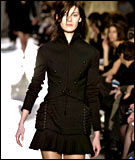
Poor Nicolas Ghesquière. After it was revealed earlier this month that the beautiful boy wonder at the head of Balenciaga had copied the most photographed showpiece of his spring collection – a vest – tassel-for-tassel, some people assumed he would become the Doris Kearns Goodwin of the fashion world.
Who busted Ghesquière?
It was a 22-year-old vintage dealer, Sameer Reddy, who stumbled on a photo of the original, identical vest, by hippie designer Kaisik Wong, who died from an AIDS-related disease in 1990. Reddy’s ability to detect even the most oblique of references makes him one of a new elite corps of fashion cops – enforcers of the industry’s institutional memory. Mark Walsh, another vintage dealer, loves to point out who got what from where. “Didn’t those vests look like that ‘Wearable Art’ that Cher used to wear in the seventies?” he exclaims, poring over the Flokati-rug affairs from Ghesquière’s fall collection.
The word on the street is that, in fact, Ghesquière was looking for Wearable Art for years, but dealers didn’t want to sell it to him. The notion of a designer armed only with a sketch pad is largely a myth. It may come as a shock to customers, but most designers regularly dispatch staff worldwide to scour vintage depots in search of inspiration. (The fashion world is stalled in a staunch postmodernism, where success is measured in the ability to synthesize various influences and make them commercially viable.)
These designers buy up bags, belts, or even a coat and then limit their pilfering to the details: the stitching here, perhaps, or a buttonhole there. But they usually stop a hemline short of producing a direct copy.
Which raises another point: Vintage dealers not only spot the knockoffs but also control the inspiration supply. Walsh, for example, is particularly choosy about who gets access to his fabulously comprehensive collection of twenties and thirties dresses. “I wouldn’t sell most people a Vionnet dress,” he sniffs, “because I know the degree to which it’s going to be abused.” He even rejected one designer who begged to sketch a Vionnet dress because, he explains, “her stuff is, like, soooo ugly.”
Seth Weisser is co-owner of What Comes Around Goes Around, a vintage store in SoHo that keeps a separate showroom exclusively for design teams. “Remember that Celine double-wrap belt with the metal on the outside? The original was from us. It’s exactly as it was,” he claims. Naturally, Weisser plays favorites. “When the good stuff comes in, there are about five designers who get the call.”
Of course, as much as they enjoy their detective work, the dealers also understand that fashion, as Reddy puts it, is all about “cloaking yourself in familiar imagery.” Walsh points to John Galliano, who he claims used the copying process to perfect his craft. “He used to do line-by-line copies of Poiret and Chanel dresses,” says Walsh, “but now it’s so totally deconstructed and synthesized that it doesn’t look like anyone but him.”
And, with a wink, they know where to look next.
“Every time the Fashion Institute of Technology or the Met does a big show, everyone just copies it,” says Leslie Chin, Walsh’s partner. He refers to the Bonnie Cashin retrospective at FIT two years ago; Cashin vastly influences Marc Jacobs, Michael Kors, and, by proxy, just about everyone else.
So if you want a head start on fall 2003, just think Joan Crawford, as the Met plans its Gilbert Adrian retrospective. “Coming soon,” cries Chin. “High Hollywood glamour!”